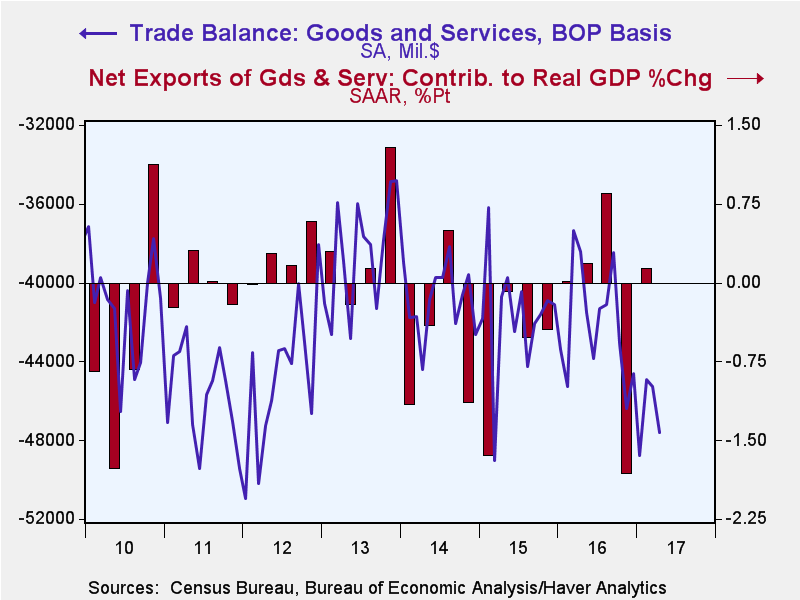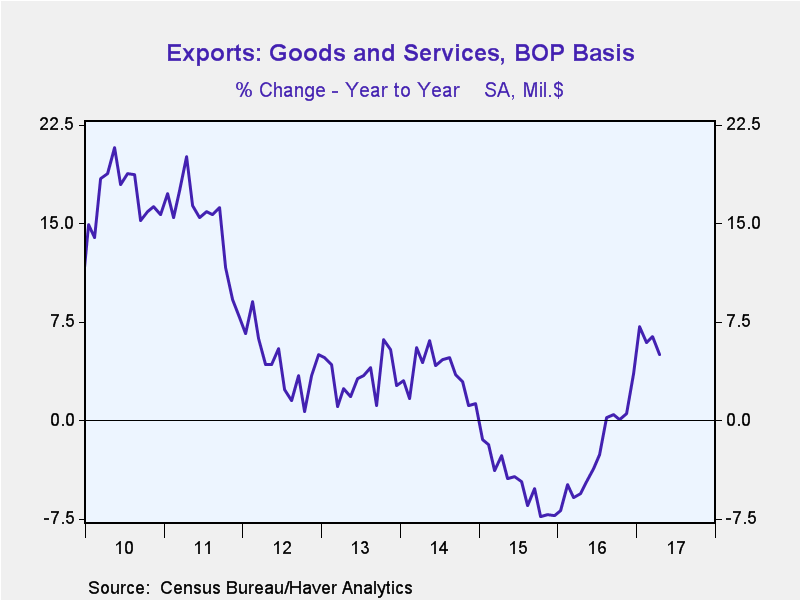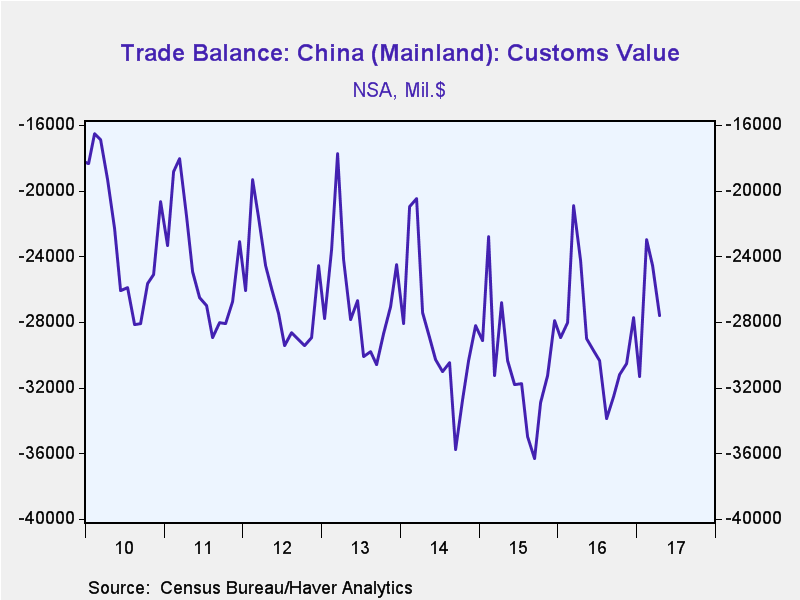 Global| Jun 02 2017
Global| Jun 02 2017U.S. Trade Deficit Widens as Exports Ease and Imports Rise
Summary
The U.S. trade deficit in goods and services widened to $47.6 billion in April, compared to $45.3 billion in March, initially reported as $43.7 billion, and $38.4 billion in April 2016. Expectations had been for a $45.8 billion [...]
The U.S. trade deficit in goods and services widened to $47.6 billion in April, compared to $45.3 billion in March, initially reported as $43.7 billion, and $38.4 billion in April 2016. Expectations had been for a $45.8 billion deficit in the Action Economics Forecast Survey. Total exports fell 0.3% (+5.0% y/y) after a 0.1% downtick. Imports rose 0.8% (+8.3% y/y) in April following a modest 0.1% rise in March. This report includes annual revisions, which were routine this year and had little overall impact.
Merchandise exports decreased 0.3% in April (+6.3% y/y), a repeat of March's -0.3%. There were declines in consumer goods, autos and "other"; consumer goods exports fell 4.3% (+0.5% y/y), autos 4.1% (-2.3% y/y), and "other" 3.0% (+8.8% y/y). On the plus side, food, feed & beverages exports rose 5.1% (19.8% y/y) and industrial materials & supplies 1.2% (15.8% y/y). Capital goods shipments were unchanged (+0.4% y/y) in April.
Services exports edged higher 0.1% (+3.1% y/y). For categories ranked by dollar amount, travel by foreign tourists in the U.S., $17.6 billion in April, increased 0.6% (+3.7% y/y), revenue from business services, $11.8 billion, increased 0.1% (+1.2% y/y) and charges for the use of intellectual property, $10.2 billion, were unchanged (-2.9% y/y).
On the import side, merchandise purchases grew 1.0% in April (+9.5% y/y). The growth was in nonpetroleum goods, up 2.3% (+7.2% y/y). Petroleum imports, by contrast, dropped 12.2% in the month, although they were up 45.2% y/y. This reflected an increase in the price of crude petroleum of 53.7% to $45.40 from $29.53 in April 2016. The quantity of energy-related petroleum product imports fell 1.4% y/y.
Among nonpetroleum goods imports, nonauto consumer goods rose 4.0% (+8.7% y/y), food, feed & beverages 3.3% (+6.9% y/y) and capital goods 1.8% (4.3% y/y). Imports of industrial materials & supplies (which do include petroleum) fell 3.4% (+24.% y/y) and auto imports were down 2.2% (+4.4% y/y). "Other" goods imports rose 10.3% (+5.0% y/y).
Services imports were up 0.2% (+4.0% y/y). Travel, also the largest category of service imports at $10.2 billion in April, rose 1.0% (+5.0% y/y). Transport service imports, $8.2 billion, fell 1.6% (+1.9% y/y) and business services imports, $8.1 billion, edged lower by 0.2% (-3.0% y/y).
By country, the trade deficit with China deepened further to $27.6 billion from $24.3 billion in April 2016. Exports to China rose 13.5% y/y while imports rose 13.7% y/y. The trade deficit with the European Union increased to $12.5 billion versus $12.0 billion one year earlier. Exports to the EU eased 0.2% y/y while imports rose 1.4% y/y. The trade deficit with Japan decreased to $5.2 billion from $6.2 billion twelve months earlier. Exports to Japan surged 27.3% y/y and imports were up 3.0% y/y. These country data are not seasonally adjusted.
The international trade data can be found in Haver's USECON database. Detailed figures are available in the USINT database. The expectations figures are from the Action Economics Forecast Survey, which is carried in the AS1REPNA.
| Foreign Trade in Goods & Services (Current Dollars) | Apr | Mar | Feb | Y/Y | 2016 | 2015 | 2014 |
|---|---|---|---|---|---|---|---|
| U.S. Trade Deficit | $47.6 bil. | $45.3 bil. | $44.9 bil. | $38.4 bil. (4/16) |
$504.8 bil. | $500.4 bil. | $490.3 bil. |
| Exports of Goods & Services (% Chg) | -0.3 | -0.1 | 0.1 | 5.0 | -2.5 | -4.7 | 3.6 |
| Imports of Goods & Services (% Chg) | 0.8 | 0.1 | -1.5 | 8.3 | -1.9 | -3.6 | 4.0 |
| Petroleum (% Chg) | -12.2 | -4.2 | 8.2 | 45.7 | -19.4 | -45.5 | -9.7 |
| Nonpetroleum Goods (% Chg) | 2.3 | 0.5 | -2.8 | 7.2 | -1.2 | 2.2 | 6.5 |
Carol Stone, CBE
AuthorMore in Author Profile »Carol Stone, CBE came to Haver Analytics in 2003 following more than 35 years as a financial market economist at major Wall Street financial institutions, most especially Merrill Lynch and Nomura Securities. She has broad experience in analysis and forecasting of flow-of-funds accounts, the federal budget and Federal Reserve operations. At Nomura Securites, among other duties, she developed various indicator forecasting tools and edited a daily global publication produced in London and New York for readers in Tokyo. At Haver Analytics, Carol is a member of the Research Department, aiding database managers with research and documentation efforts, as well as posting commentary on select economic reports. In addition, she conducts Ways-of-the-World, a blog on economic issues for an Episcopal-Church-affiliated website, The Geranium Farm. During her career, Carol served as an officer of the Money Marketeers and the Downtown Economists Club. She has a PhD from NYU's Stern School of Business. She lives in Brooklyn, New York, and has a weekend home on Long Island.









